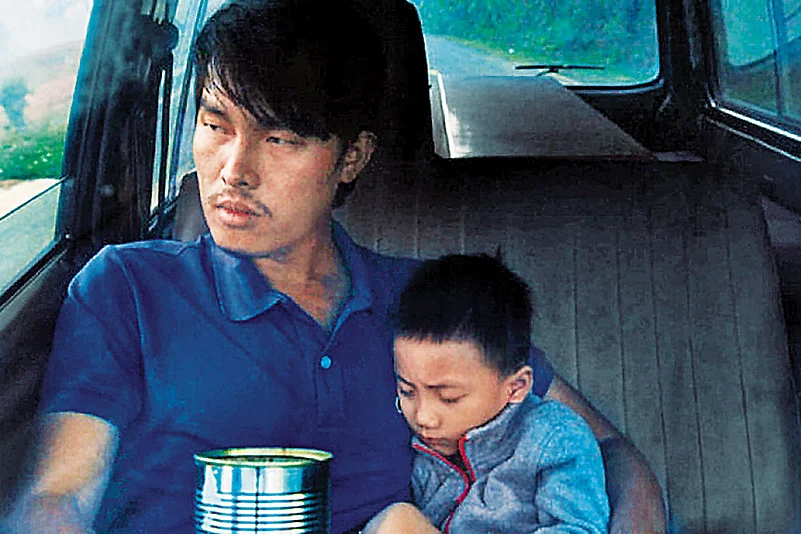As the 77th Cannes Film Festival is drawing close, I am tempted to relive the cinematic splendour of last year’s lineup. Inside the Yellow Cocoon Shell, directed by Vietnamese filmmaker Pham Thien An, won the prestigious Camera d’Or (Best Debut Feature Film) award at Festival de Cannes in 2023. This unforgettable film explores the pursuit of faith and the meaning of life with astounding cinematic finesse. Following in the legacy of Tsai Ming Liang and Apichatpong Weerasethakul’s slow cinema, this three-hour-long film captivates audiences, seamlessly obscuring the lines between dream and reality, illusion and actuality. It draws us into the journey of the protagonist Thien (Le Phong Vu), inviting us to share the depths and wonders of his experiences.
Of Faith And Fleeting Dreams
The Camera d’Or (Best Debut Feature Film) winner at Cannes, 2023 is slow cinema at its best

Thien is a young man living in Saigon, where he works as a wedding videographer and cherishes the time he spends with his friends. However, tragedy strikes when his sister-in-law dies in a motorbike accident. Thien takes on the responsibility of caring for his five-year-old nephew, Dao (Nguyen Thinh). He returns to his rural hometown for the funeral and to arrange for Dao to live with relatives in the countryside.
As Thien embarks on this arduous journey, he is confronted not only with the task of locating his estranged brother who had left his now-deceased wife and their son, Dao, but also with profound discussions about faith, loss, dreams, and mortality. Through it all, he finds himself deeply affected by Dao’s calm, casual coping mechanisms for dealing with his mother’s death. This experience prompts Thien, and perhaps viewers as well, to reflect on their own inner child and the lost era called innocence.
The film can be viewed as three cohesive segments. The first one depicts the bustling city life in Saigon, where the protagonist grapples with his sister-in-law’s death, leaving behind five-year-old Dao. Thien reluctantly assumes responsibility for Dao as they embark on a journey to the mountainous countryside, carrying his sister-in-law’s body in a coffin. The second segment unfolds slowly, mirroring the unhurried pace of rural living. This deliberate pacing sets the stage for Thien’s introspection as he yearns for something beyond the tangible. Here, his little nephew assumes the role of an angelic catalyst. During a moving moment at his mother’s funeral in the village church, Dao innocently asks Thien about faith: “Uncle, what is faith?” Thien reflects on his own search for faith and attempts to explain it to Dao using a simple analogy involving lending toys to a classmate: “Have you ever lent your toys to a classmate? And did you think your friend would give it back?” As Dao replies, “Yes, of course,” Thien sums it up, “Faith is a little bit like that.” Through this exchange, the film delves into the nuances of faith, driving the narrative forward. Thien’s attempt to explain “faith” to Dao without resorting to religious doctrine, using a relatable and simple example from daily life, underscores the simplicity and universality of the concept.

The scene where Thien performs a magic trick for Dao, creating an illusion of colourful fish in a jar, encapsulates the theme of faith beautifully. Dao’s innocent belief in the magic, despite the absence of real fish, highlights the power of faith to shape perceptions and provide comfort in the face of uncertainty. This moment, open to interpretation as either deception or genuine faith, encapsulates the quintessential magic needed to navigate life’s challenges.
The third segment delves into Thien’s quest to find his estranged brother, leading him on a solitary journey along fog-shrouded, winding hill roads. Armed with a photograph from his wedding, Thien asks locals about his brother’s whereabouts. Some of them note a striking resemblance between Thien and the man in the picture. Eventually, he encounters a woman, likely his brother’s second wife, nursing her newborn. Entrusting Thien with the baby, she guides him to a field where his brother may be found. There, Thien stands alone with the infant in his arms until he hears Dao’s voice addressing him as ‘Uncle Thien’.
The reverie shatters when Thien awakens to find himself lying beside his bike near a stream, prodded by a disgruntled passerby urging him to move his vehicle. Inquiring further about his brother, Thien learns that there’s no one matching his description. Ultimately, Thien disrobes and lies down on the riverbed, submerging himself halfway in the water.
I perceive the film as unfolding in three distinct temporal parts, each subtly mirroring the flow of time in Thien’s life and, by extension, our own. These segments represent the past, present, and future. The past segment confronts us with the harsh realities of Thien’s history, interwoven with poignant memories. Despite any nostalgic longing or regret, the immutable facts of the past remain unchanged. It’s akin to residing in a city where one must confront the inevitability of circumstances. Tragedy strikes, leaving Dao orphaned—a poignant reminder of life’s unpredictable twists.

In the present segment, we find ourselves at a delicate juncture where decisions must be made. The present, often slipping through our grasp like fine sand, allows us a rare opportunity to pause and reflect, as depicted in Inside the Yellow Cocoon Shell. Thien, faced with the responsibility of Dao’s education, chooses to enroll him in a missionary school, where serendipity reunites Thien with his former lover, who is now leading an ascetic life. Here, the past and the present converge, grounding us in a moment of introspection and choice.
Finally, the future segment offers a tantalising glimpse of what lies ahead—a realm of uncertainty, possibility, and longing. It beckons us with fleeting dreams and elusive promises, yet retains echoes of our present reality. Just as Thien’s journey unfolds, so too does our own, characterised by a perpetual quest for meaning and fulfillment.
The cinematographic narrative by Dinh Duy Hung seamlessly aligns with the underlying philosophy of the script, unfolding through poignant yet extended shots. With minimal cuts, the narrative advances through a steady movement of the camera. The camera patiently stands and observes when required, maintaining an unobtrusive yet intimate distance from the subjects or characters. This cinematic narrative pattern naturally elevates the film to a profound level where visual and camera movements engage with the audience harmoniously without disrupting the script’s narrative flow.
The sonic treatment of the film invites viewers to immerse themselves fully in Thien’s quest. From merely watching, we as viewers start partaking the country living experience—from cock fights to church prayers. Thien’s bike journey across the foggy mountain roads engulfs our existence especially when his rides take us to a misty path where absolute silence reigns. Not a note to be heard except the sound of your breathing or the silent weeping of your heart.
My personal takeaway of this film is its profoundly Eastern essence. Deliberately avoiding the term “oriental’’, which carries a Western gaze, Thien Phan An’s ‘Yellow Cocoon Shell’ immerses us in the depths of our Eastern heritage, both spiritually and aesthetically. Its unhurried pacing encourages viewers to contemplate truth’s stillness and life’s fluidity.
(The Cannes Film Festival will be held this year from May 14 to 25)
Debarati Gupta is a Filmmaker, Columnist & Guest Lecturer at Calcutta University
(This first appeared in the print as 'Of Faith And Fleeting Dreams')
- Previous Story
 Joker: Folie à Deux Review: Joaquin Phoenix and Lady Gaga Can’t Rescue a Flubbed-Experiment Sequel
Joker: Folie à Deux Review: Joaquin Phoenix and Lady Gaga Can’t Rescue a Flubbed-Experiment Sequel - Next Story


























